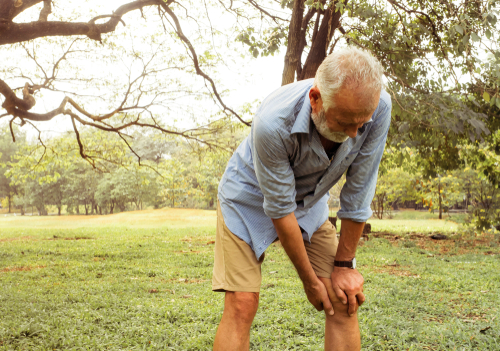It’s common to notice occasional stiffness in your joints in the days after a hard workout or a physically demanding project. Moving and installing flooring or roofing can be particularly hard on your knees. But it can be worrisome to realize that you suddenly can’t bend your knee or extend it all the way.
It can be hard to tell why this is happening without doing a thorough physical assessment. Keep track of your symptoms so you know how long your knee has been stiff and when you notice it the most. If your knee is hurting, you can try the RICE method to reduce inflammation and pain: rest, ice, compression and elevation. Some rest and gentle stretching may be enough to get your knee moving again. If your knee has been stiff for more than a week or if you’re in a lot of pain, you should see a physical therapist.
This article covers seven reasons why you may not be able to bend or extend your knee all the way.
Why can’t I bend my knee all the way?
Typically, when a knee joint is truly locked, it’s because of an injury like a torn meniscus, a torn ACL or a fracture. These conditions are all pretty painful, and they usually happen after a traumatic injury. It is possible to have a knee sprain without a lot of pain, and this can keep your knee joint from moving freely.
A few other conditions can make it difficult to bend your knee or extend it all the way. Muscle weakness, osteoarthritis, and patellofemoral pain syndrome, also known as runner’s knee, are all common reasons. Bursitis of the knee and runner’s knee are often caused by overuse; you can also get runner’s knee if you have tight hamstrings or a tight Achilles tendon. Irritation of the tendons in your knee and scar tissue from a past injury or surgery can both make movement difficult.
7 reasons you may have trouble bending and extending your knee
Your knees are complex joints with lots of moving parts. Your kneecap and leg bones are attached with ligaments, and tendons are the strong pieces of tissue that connect your muscles to your bones. The entire joint is surrounded by a bursa, which is a fluid-filled sac that cushions the joint and allows for smooth movement.
Different parts of the knee can become stiff or irritated for different reasons. Sometimes it’s a mechanical issue like an imbalance, tightness or weakness. There may be remaining scar tissue from a past injury or a surgery that’s preventing movement. Repetitive movements can cause inflammation and irritation, especially if you haven’t been getting much exercise. In some cases, it might be the first sign of osteoarthritis.
Any of the following conditions can make it hard to bend and extend your knee all the way without pain:
- Muscle weakness — A weak muscle may not be able to fully extend, affecting your ability to bend or straighten your knee. If a muscle becomes particularly weak from not getting enough movement, it can become stiff and hard to move. Before you start strengthening stiff muscles, you may need some gentler treatments to mobilize them so you don’t injure yourself.
- Tendinitis — Tendinitis can be caused by overuse, repetitive movements or an acute injury. It’s when tendons in a certain area and sometimes muscles become inflamed and irritated. Tiny tears in the tissue cause soreness and sometimes limit movement. You may also notice a grinding or popping sensation. Patellar tendinitis is common, and it’s sometimes known as jumper’s knee. You may be more likely to get patellar tendinitis if you play sports that require a lot of jumping, like basketball and volleyball.
- Bursitis — Each of your joints is filled with fluid, contained by bursae or sacs that cover your joints. When this fluid gets stagnant or your knee joint is irritated, it can become painful and get in the way of proper movement. Bursitis can be caused by overuse, too much kneeling, or even a bacterial infection that spreads from a cut or scrape.
- Patellofemoral pain syndrome — Known as runner’s knee, patellofemoral pain syndrome can be caused by overworking your knee joint while running or walking. You may be more likely to develop it if your kneecap is too high in the joint or if you have weakness or tightness in your legs. Most people notice pain and a popping or cracking sensation. If left untreated, it can start to wear away the cartilage on the back of your kneecap.
- Arthrofibrosis — This condition often happens after knee surgery, causing a lot of stiffness, inflammation and tenderness. It’s caused by a buildup of excess scar tissue, so it’s sometimes called “stiff knee syndrome.” People with this condition need physical therapy treatments to break up the scar tissue before they can start stretching and exercising their knee on their own.
- Osteoarthritis — Osteoarthritis is a degenerative condition that happens as part of the aging process. It’s when the cartilage at the ends of the bones wears away. You may notice a grinding sensation or stiffness, and people often notice osteoarthritis in their knees first. Symptoms are often worse after strenuous activity.
- Knee sprain — There are four ligaments in your knees that can be sprained: the lateral collateral ligament (LCL), posterior cruciate ligament (PCL), anterior cruciate ligament (ACL) and medial collateral ligament (MCL.) This usually happens because of a traumatic injury, and it’s often painful, but not always. A sprain can limit your ability to move your knee.
How can physical therapy help me get my knee joint moving?
A physical therapist can help with any of the conditions listed in this article. In general, physical therapy promotes healing by increasing circulation in affected areas and stimulating your immune response to help your body reabsorb scar tissue. At SOL PT, we often begin with manual techniques to help loosen up muscle fibers, and then follow up with a combination of stretching and exercise that can help rehabilitate weak muscles. Your physical therapist will educate you about what’s happening in your body and how you can prevent further injury. They can help you navigate any lifestyle adjustments, such as using a knee brace, that will help you care for your knee.
At SOL PT, we use a method called Active Release Techniques® (ART). This involves gentle touch to mobilize soft tissue and break up any scar tissue causing stiffness. It can also help flush out trapped fluid in your joints and stimulate the lymphatic system, which can decrease inflammation.
Get help rehabilitating your knee at SOL PT
It’s easy to take your joint health for granted — until you start having problems. We use our knees every day to get around, bend over and kneel down. Pain and stiffness can really get in the way of your day-to-day routine.
There are likely some simple and natural treatments that can mobilize your knee joint and limit your pain going forward. Our first step at SOL PT is always a thorough assessment to learn about your activity, your symptoms and your treatment goals. We’ll also do some physical tests to see how your knee is currently functioning. From there, your PT will create a personalized treatment plan that targets your specific symptoms.
Are you ready to find out what’s causing your knee stiffness? Call us or request an appointment today. Let’s talk about it and create a treatment plan together to get you moving again.


